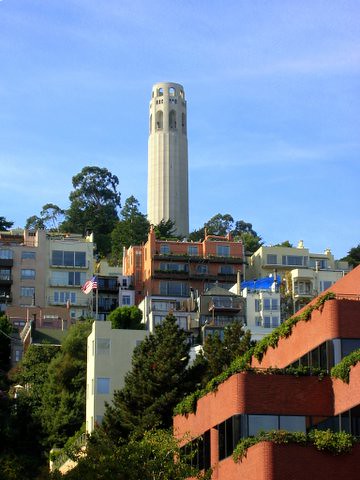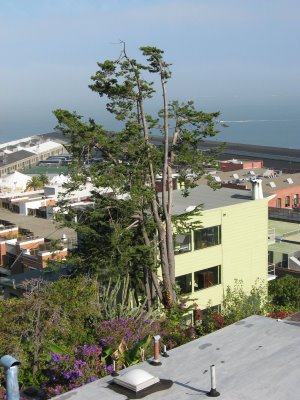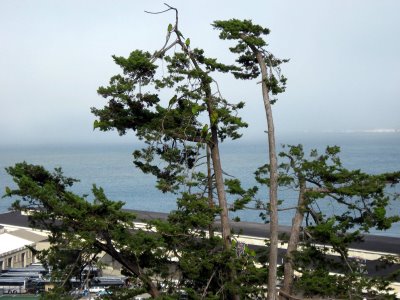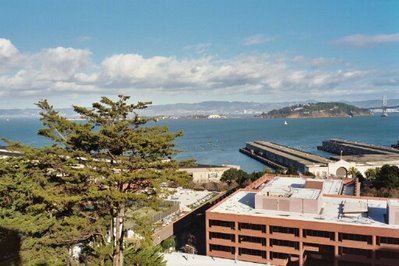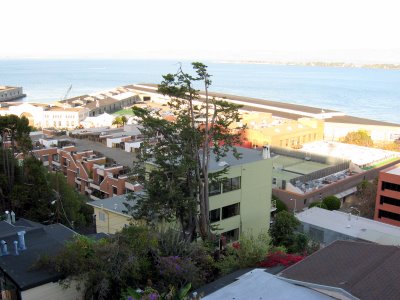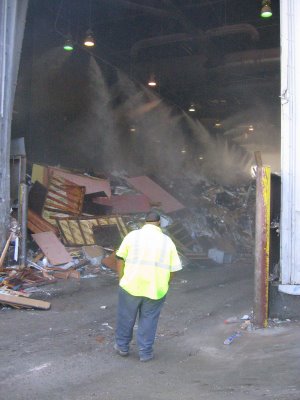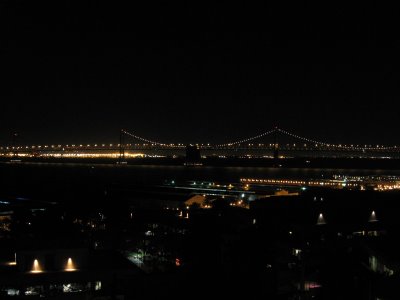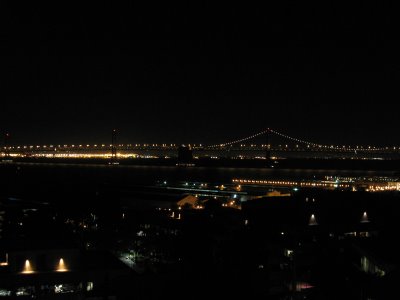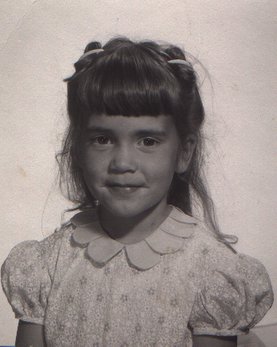Chris Jordan's latest photography set.
These photographs of albatross chicks were made just a few weeks ago on idway Atoll, a tiny stretch of sand and coral near the middle of the North Pacific. The nesting babies are fed bellies-full of plastic by their parents, who soar out over the vast polluted ocean collecting what looks to them like food to bring back to their young. On this diet of human trash, every year tens of thousands of albatross chicks die on Midway from starvation, toxicity, and choking.
Labels: environmentalism, photographs, science
Why not?
Update: Ah. ... A federal appeals court agreed Wednesday [27 Feb 2008] that state air pollution regulators can't order ships arriving at California ports to reduce their toxic contributions to local smog." The Court ruled that the State Air Board's rules couldn't take precedence over the federal Clean Air Act and the state would have to get a waiver from the EPA to allow its rules to go into effect.
OK. So when is =that= going to happen, now that TPTB at the EPA have changed? Soon? Have we asked?
Labels: economy, environmentalism, health, photographs, politics, SanFranciscoBay, ships
Earth Day. I donít know how I feel about it, as a day, which mostly feels like yet another opportunity for capitalism to taint what should be common sense.
I remember the first Earth Day. 1970. A few months before Sara Zarr was born. Spring semester of my freshman year. We buried a new car (a Ford Maverick?) in the Quad at San Jose State during the Earth Day Survival Fair. Oh, we were root-toot-tooting greenies even back then.
Looking back, though, the green we are today wouldn't even have been dreamed of back then. Sara went through some of the things she's now doing ("a few of the major though easy things") that help celebrate Earth Day year-round. Here's my list of ten greenie things that are part and parcel of my life these days.
1) WATER Like Sara we don't do bottled water -- not at home, not in restaurants. (Well, if someone else is paying for the con-gas/frizzante at an event, I will certainly imbibe. My no-frizzante-at-restaurants is because I'm way frugal too ... Why pay a restaurant for a marked-up bottle of water? Why buy water at the store? I appreciate restaurants that fizz their own water instead of bringing on the French or Italian bottled stuff.
Our local HetchHetchy water is fine water indeed. I understand that some other folks may not have tap water that tastes good. (I've been in Midland, TX. Reverse osmosis water is the ONLY way to go in that town.) But if you don't live in Midland or some place with equally bad water, have you even considered tap (or as an office mate used to say, "sink") water?
Sara doesn't live in San Francisco these days, but where she is her tap water's fine too. Are you missing out on drinking from the tap because it's "sink water"?
We have a couple bottles of chilled water in the frig for (f'rex) when we're going out for a walk on a hot day (to avoid getting so terribly thirsty that we break down and buy a bottle at the wharf). We refill our bottles. Again and again and ...
We have a case of bottled water under the bed as part of our earthquake supplies.
That's it.
2) BAGS: PLASTIC & OTHERWISE We reuse paper bags and packaging materials. And those peanuts &c. that show up in mailorder stuff that we can't use? We give those to a friend who is slowly decluttering his house by selling stuff on eBay. We stuff clean plastic (which isn't recyclable with the city recycle program in this town) into a large plastic bag and when the bag's full, take it down to Safeway, which does, still, recycle plastic. We save the larger grocery-sized plastic bags to line the wastebasket in the kitchen.
We have cloth bags (and, for Trader Joe's, paper bags) for shopping. Most of the cloth bags are from conferences: Bouchercon, AAAS, LCC. We have HUGE STURDY IKEA BAGS that we bought for $0.59-$0.99 each (they dropped the price and we bought two more) which we use to haul stuff in from the car down the stairs and up to the front door when we take the car to Costco or Trader Joe's and buy in bulk. We also use them to haul stuff UP! so we have a couple bags on either end. We have had these bags now for years and they carry a ton of stuff without wearing out or ripping at the seams.
2a) I wrap presents in Sunday comics. Did you know that you can cut long strips of comics (or any wrapping paper, really) and curl the strips with a knife/scissors edge to make ribbony attachments that MATCH!! the wrapping paper? I wrap packages for mailing in paper bags, deconstructed at the seams and turned inside out.
3) RECYCLE We recycle newspaper, magazines, cardboard, flattened boxes, clean paper items, bottles and cans, plastic bottles, &c. We stash the recycle stuffs in boxes and on the day before the twice-a-week pickup, we transfer them to paper grocery bags and carry them up to the nearest street and leave them in a recycle bin there for pickup. We empty the bags that hold bottles/cans into the bin and bring the bags back for re-use. The bags holding magazines/newspapers, we leave in the bin.
4) GREENCYCLE San Francisco has a wonderful compost program -- green bins or, as we call it, Greencycle. What can you put in the green bin for composting? All food scraps, food-soiled paper, garden clippings and cuttings, pizza boxes, paper milk cartons, tea bags, coffee filters, banana peels, food-soiled paper napkins, wooden crates, tree trimmings, sawdust. Oh, the list goes on. Fish bones, lobster and crab shells, oyster shells, bones, wine corks.
The only things that shouldn't go in the green cart are (1) things that are already recycled in the blue bin: newspaper, clean paper items, bottles and cans, empty spray cans, aluminum foil, plastic bottles, tubs and lids, &c. and (2) things that belong in the real garbage:
* Styrofoam
* plastic bags
* diapers
* kitty litter or animal feces
* rocks, stones, or dirt
* &c.
How hard is this? Well, for us, we have to make more effort than someone living in a SFH with curbside pickup. Where we are, the City will not pick up recycle or compost. A bunch of greeny neighbors FINALLY arranged for the City to pick up recycle if we carry it up to the nearest street and tuck it down on the first landing. (The neighbors on either side of the steps complained if we put the recycle bin on the sidewalk next to their buildings.) Greencycle, though, is out of the question at that spot.
Our Greencycle effort goes thusly. We have a large glass casserole dish on the counter that gets the stuff that would go into the green bin, if we only had a green bin. When the dish gets full (or at the end of the day), we transfer the contents to a large, lidded, metal menudo pot (lined with a compostable bag), which sits over in the corner of the kitchen.
When that bag gets full (or in four days, whichever is sooner, because the compostable bag begins to compost at that point), we put the bag into a larger plastic bag and take it out and drop it sans plastic bag in a green bin that we know of that's on our way out-of-town or over to Costco or somewhere else that we'd be heading anyway. I suppose we could find a neighbor with a green bin (Hey! I may know just the one!) who lives within a quarter mile who would let us drop the Greencycle in her bin.
Greencycle is so very cool. I wish everyone used it.
As the article linked above says,
San Francisco's garbage and recycling companies are leading the way in producing a high-quality, boutique compost tailored for Bay Area growers, experts say. In one year, 105,000 tons of food scraps and yard trimmings - 404 tons each weekday - get turned into 20,000 tons of compost for 10,000 acres.
Greencycle recycles 105,000 TONS of food scraps and yard trimmings a year! How cool is that?
5) PACKAGING AND PLASTIC WRAP We don't buy many things that are in non-recyclable packaging. We still eat meat, so there are usually styrofoam trays (why?) to dispose of and the plastic wrap around them. Vegetables go into plastic bags before purchase, but if you rinse them out and dry them, the plastic bags recycle. Cheese is wrapped in plastic. Bulk rice comes in tough plastic bags. But we don't buy a lot of bagged, canned and bottled stuff, and what we do is usually in recyclable containers or something that can be Greencycle'd.
5a) When we heat things in the microwave, we tend to either use dishes with glass lids or put the food on a plate and cover the food with an inverted glass casserole dish from the cupboard. (We have several sizes.) The steam stays in. There's no plastic wrap to deal with. You can see through the glass dish to see how things are progressing. Wash the casserole dish afterwards. Reuse.
5b) All in all we probably have half a grocery bag of "garbage" a week. If that. (And the "garbage" bag is a plastic grocery bag from Chinatown now that the majors aren't allowed to give out plastic bags in our fair ville.)
6) WALK & PUBLIC TRANSIT We don't drive much. His nibs drives to work in the south bay once a week. Unfortunately, even though his company is now near a train station, the logistics are impossible for him to take the train to work unless he got out of here soon after 5A to catch the bus that would take him to the train station. Car it is. We also take the car when we're going to Costco or if we're planning to pick up A LOT of wine, &c. at Trader Joe's. Other than that we walk or take public transit. The nearest Trader Joe's is a mile each way. Coming back up hill with a bag or two of groceries each is doable. (We bring our own bags, 'natch.) We walk to dinner or down to the library or out. We do our veggie shopping in Chinatown and pickup our sweetbreads at Little City and walk (uphill) home. If we're going out to dinner somewhere too far to walk, we take public transit. We've taken one cab ride since we started living here and that was shared with fellow diners after a Subculture Dining experience that ended too late. The J-Church had stopped running. Really.
We currently have two cars (with -- ouch! -- the leased parking fees they incur). Eventually, when the older younger guy gets his license, he's due to get the 2000 Honda and we'll be down to the 2005 Mini Cooper. After his nibs stops working in the south bay altogether, we'll probably go carshare. My Mini Cooper consistently gets about 33 MPG. When we drove down to my cousin's memorial service and back, it got 36MPG, iirc.
We don't belong to a gym. The walking and the stairs and the carrying of groceries is pretty good exercise.
6) ELECTRONICS AND PAINT San Francisco has great hazardous waste dropoff/recycling. San Francisco residents can drop off household hazardous waste at the Tunnel Avenue transfer facility. Hazardous wastes accepted include batteries (large and small), paint, chemicals, motor oil, used oil filters, fluorescent bulbs, antifreeze, &c. Norcal tries to reuse as much of the "hazardous waste" as possible. Collected latex paint, for example, is available free to anyone who stops by (sometimes remixed, sometimes as donated) in large buckets. Customers can drop off up to 30 electronic items per month for free if they are delivered separate from any other garbage. You don't need to wait for the special "hazardous waste" days and hours. If all you are dropping off is electronic items, you can bypass the line of people waiting to use the public dump facility.
If you have BIG ITEMS that need pickup, you make arrangements with NorCal and they'll pick them up. When we got rid of the BULKY air conditioner that had been here when we bought the place (which was really pretty useless and took up space), we called NorCal and they sent someone out to pick it up. We paid extra to have him carry it down from our top floor, down our stairs and up the path/stairs to the street. We're no fools. The extra charge was well worth it.
7) WATER CONSUMPTION We watch water use. Short showers. Large loads of laundry. Handwash/air-dry dishes because we really don't use enough to fill/run the dishwasher even every other day and if you don't run it that often the kitchen stinks, we've found. We hardly ever drop things at the drycleaner. When we do, we've collected a batch over a while and take it all in at one time, saving the hassle of dropoff and pickup.
8) ENERGY We have photovoltaic cells on the roof with battery backup. Our meter runs backwards. The solar covers about half our use, which leaves us with a minimal power bill. No A/C. Turn off the lights. No TV. We use sweaters and sweatshirts on colder days rather than cranking up the (gas) heat. We're using compact fluorescent light bulbs, even though there are still questions how (years down the road) CFLs will be disposed of.
9) MAGAZINE RECYCLE AND ALTERNATIVES We just joined the Mechanics Institute Library downtown. I plan to give up most of our magazine subscriptions and save money and save the paper that then needs to be recycled by reading most of my magazines, and ones I don't currently subscribe to, there. Yes, I know. Magazines are having tough times. My subscriptions weren't enough to sustain them anyway.
10) THRIFT STORES, GOODWILL, FLEA MARKETS, BARTER I love thrift stores. Buy a dress or shirt or whatever that someone else bought first and you're saving all the associated construction/manufacturing costs that went into the original product. The current issue of San Francisco Magazine interviews Cris Zander of Cris, consignment boutique at 2056 Polk St., which has been in business for decades. (Full disclosure: I've never been there, although I might take a peek in to see if the prices are way over my wallet.)
The writer asked Cris about her ladies-who-lunch clientele who use her boutique to sell the clothes they don't plan to wear anymore and (perhaps) pick up alternatives. She quoted one of her clients who wondered why people worried about buying "used" clothes: "All of the clothes in my closet are used," the client said.
Exactly, I thought. But then I always got plenty of hand-me-downs from my three-years-older sister while I was growing up.
***
I look at the list I just made and think, yeah, fine, but you can do better than that. If we were vegetarian, we'd avoid all the expenses associated with raising meat. We could be more conscientious with buying locally. We still have two cars, fer pete's sake, but that will change. We have plants that are purely ornamental. Bottles and cans don't recycle easily as people would like to think. There's a glut on newsprint and cardboard because the cheap trinket folks are making fewer cheap trinkets in this downturn and don't need as much packaging. And what really happens to the plastic bags we take to Safeway?
And, as always when I buy something (or even pick it up free), do I really need that? Do I need that book? Do I need that stuff I picked up at Bonham's/Butterfield yesterday? Can I cut back?
Sure.
Labels: culture, environmentalism, life, San Francisco
RIP, Michael Crichton.
Crichton drove me nuts some times. His skepticism of global climate change and global warning encourage the nutcases.
STATE OF FEAR (2005) was lecturing and personal lobbying at its worse. The science wasn't true and Crichton based his story on "information" that wasn't.
Jeff Masters, chief meteorologist and co-founder of wunderground.com* reviewed the book and the science. Read it and see why my teeth grind when I think of that book.
That said, Crichton entertained me over the years. His tales were gripping. He was a smart guy who knew a lot and knew how to weave what he had into intriguing, page-turning books. He helped pay his way through college writing novels, medical thrillers. In 1969, Crichton won an Edgar for A CASE OF NEED, written under the pseudonym Jeffrey Hudson, probably because of its subject matter: abortion. (We're talking 1968 here.)
ANDROMEDA STRAIN, JURASSIC PARK and ER are fitting legacies.
RIP.
*(Weather Underground, a weather service of which our uphill neighbor, not William Ayers, is president of the BoD.)
Labels: books, environmentalism, people, writing
Read the article.
Read the comments.
People can be such whiners. Gestapo! It's so hard to recycle. &c. and so on.
Yes, proposing outrageous fines if people don't sort their garbage (and maybe cutting off their garbage service ... that'll teach them!) is nonsense, but the City pays a fortune to truck garbage to the dump over by Altamont and with gas prices rising not only is the dump filling (and where will we put trash then?) but costs are rising too.
Our field trip to the dump -- AKA "Norcal Waste System, Inc's Solid Waste Transfer and Recycling Center" -- last October was enlightening.
Read the trip report with piccies to see why getting people to separate out their recyclable stuff AND ESPECIALLY THEIR GREEN CYCLE is a must if we're going to control the garbage stream (and the fuel costs and the personnel costs and ...)
That said, my comment on the Chron article:
Dear Mayor Newsom.
Come visit. I'll invite some neighbors over. We'll explain how difficult it is to recycle at all when you live off the Filbert Steps.
(1) NorCal won't pick up blue bins here. Paying extra isn't even an option. We FINALLY got a locked bin -- locked so tourists won't throw trash in -- that the immediate neighbors share up at Montgomery and Filbert, but neighbors who live at Filbert and Montgomery bitch and complain about us parking our recycling bin anywhere near their buildings. Add a green bin? As if.
(2) I have a dish on the counter for green-bin scraps. From there, the scraps go to a covered compostable-bag-lined re-purposed menudo pot over by the 'frig. Every 4 days or so -- MAX ... any more than that and the bag will disintegrate and maggots and crud grow -- we tie up the bag, put it in ANOTHER bag, walk it three-plus blocks to our car and DRIVE to drop it off in a large green bin we have access to.
We try, Mr. Mayor. 'tain't easy. Make it easier for us.
His nibs said, why didn't you write about people putting non-greencycle stuff in bins left out for pickup and the greencycle people refusing to pick up the bins? Why didn't you write about neighbors getting upset about people picking through blue bins for cash-refund recyclables and the bratty neighbors kicking the full bin and contents down the stairs, spreading recyclables down the steps to the next landing? Why didn't you write about ...
I told him that the SFChron allows you 1000char for comments and I was down to my last ten or so. ...
Labels: causes, environmentalism, San Francisco, urban
Click on the picture to get a better look. Some of the parrots were back yesterday to check out the pruned trees. They stayed longer than they usually do before heading off.
Labels: causes, environmentalism, life, politics, San Francisco, Telegraph Hill
BEFORE: (18 Jul 2004)
[note: added another before: Dec 2003]
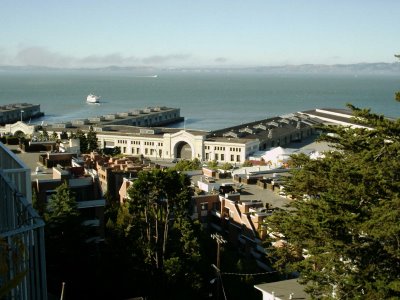
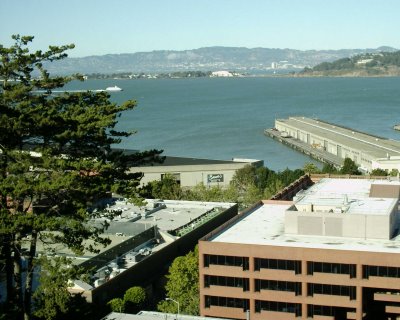
I rummaged through my photo bins to find photos of the trees as they were. These two show the north and south ends of the cypress grove on 18Jul2004. Imagine, if you will, a large clump of green between what these two photographs show.
I obviously didn't take a lot of shots of the trees standing alone.
DURING: (October 2004)
Later that year, in October, a large chunk of tree came down.
In October 2005, another tree was taken out before Mark threw himself between the trees and the tree cutters and successfully halted the project.
We all know the result: a Landmark Tree ordinance. After much negotiation, in February 2007 the City agreed to indemnify the remaining trees' owner from any liability arising from the fact he wasn't allowed to take the "rotten" (his description) trees down.
The City also agreed "to hire a special arborist who has the skill to delicately prune the trees and preserve them for at least three years -- long enough for new ones to grow to shelter the parrots. The two trees are all that remain from what was once a larger grove." [n.b. Three years to grow trees this tall? Really?]
The Northeast San Francisco Conservancy (president: Nancy Shanahan) pledged $5,000 to the City to cover the cost of pruning and care.
BEFORE: (December 2003)
AFTER: (15 Nov 2007)
What can we see that's different? (Gee, this is like those picture puzzles: find six ways this picture is different from the ones above.)
In 2004, the cypress grove obstructed the view of most of the green building you can now see to the northeast of the trees. We can now see the tennis courts on top of the Bay Club.
The trees in 2004 were considerably taller than the trees that remain. We have an uninterrupted view of Treasure Island instead of having trees obstructing our views of the northernmost third of the island. We can also see more of Teatro Zinzanni -- those tents down at Pier 29 -- and twice as much of the rooftop of the condo building to the north of the green building.
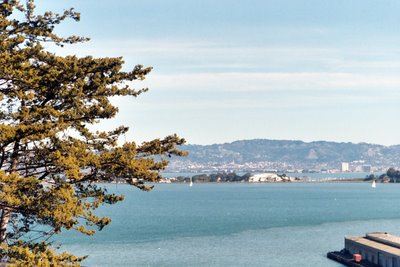
I'd taken this shot to show the tidal bore on a very boring day, but it also shows what our view of Treasure Island was in May 2004. That's a whole lot o' tree that's been taken down in the last three years.
I have mixed feelings about all this. I love trees. I miss the green stuff -- I much prefer green stuff to views of the neighbors' roofs -- but I think there was far more agitation over the poor parrots and this privately-owned cypress grove than there needed to be. I think the City spent more time and effort -- when they don't seem to have time to worry about some critical problems -- than the situation warranted. I know Mark loves the parrots and I know he made them famous with his book. If someone had said we should spare the trees, if at all possible, because they're right outside Mark's door and he wants to have the parrots right there, well, I could understand that, but that's not how all the agitation and public spin came down before the City set about changing rules, trimming trees and indemnifying the owner.
"The parrots are fine," I tell worried friends who have read the tales of woe and crisis and parrots. This bit of greenery is not what it was, but the parrots still flock to trees on Telegraph Hill. We still hear them yackyackyack yackyackyack yackyackyackyacking. They still amuse the tourists and scare the cat.
May the flock prosper and increase.
Labels: causes, environmentalism, life, politics, San Francisco, Telegraph Hill
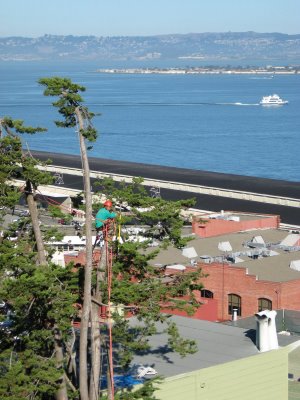
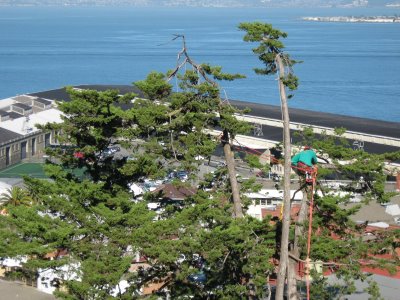
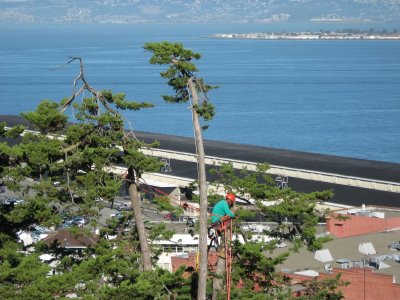
Talk about a job I wouldn't want! I can't even stand at the edge of the roof without getting shaky knees.
Tree trimmers are trimming the trees down the hill from us, trees which caused such political uproar a year ago or so and resulted in new rules regarding tree cutting on private property. Siblings of the trees were taken out three years ago. These remaining trees are supposed to remain in place and be taken care of until they can't be maintained. The City's indemnified the owner from any lawsuits that might arise should the trees topple over or break a limb.
The guy up in the tree checks his knots frequently. He has an ally on the roof of the building just east of the trees and an ally on the ground, who is cutting the fallen branches with a chain saw. The guy in the tree has done most of his work with a tree saw on a long pole but just now switched to a chain saw.
Earlier today, the neighborhood e-mail list flashed with a "someone's cutting the cypresses" note, followed by a note from Mark Bittner that the cutting was all in order.
The neighbors are watching. The parrots are sitting on someone's railing to get a better view of what's going on because their usual tree perch doesn't have a good line of sight for the trees being trimmed.
When allz done, I'll post before and afters.
Update: Gone for the day. Ropes still in trees.
Labels: causes, environmentalism, life, politics, San Francisco, Telegraph Hill
Tu Oct 30. Supervisors vote 8-3 in favor of new peakers. Symbolic vote only as the final vote to approve the contract with the folks who will build the new facility is the deal maker.
W Oct 31. San Francisco Public Utilities Commission votes unanimously in favor of the new peakers. SFPUC staff must finalize agreement with J-Power, the Japanese company that will build the facility.
Once the agreement is finalized and approved by the Board of Supervisors, work can begin. Inching our way slowly to a cleaner Central Waterfront. ...
Labels: environmentalism, politics, San Francisco
Even Aaron's gotten into the spirit of things, making a half-hearted attempt to eliminate the San Francisco Department of the Environment -- firing all its employees, keeping only the department director -- because Jared Blumenfeld, the director, is against the proposed new natural-gas-burning power plant at Potrero Point.
Ah, the smell of politics in the morning.
What is this proposed power plant and why is it taking so long to make a yay or nay decision?
Well, part of the time delay is due to political maneuvering, part of it is due to neighbors who don't want any power plant at all in their backyard (although how to shut down the existing Potrero Point power plant without creating the energy resources required by the California Independent System Operator ("CAISO") is a question) and part of it is due to folks, including Jared Blumenfeld mentioned above, who want San Francisco not to build a fueled plant but instead to tap into wind/sun/wave generation to provide the energy required by CAISO and the FEC.
Above is a picture of the existing Mirant power plant, located at Potrero Point, at the edge of the Bay at 23rd Street.
The Mirant plant consists of the natural-gas-fueled Potrero Unit 3 and three diesel-fueled peakers -- Units 4,5, and 6. The plant uses "once-through" cooling, sucking 206 million gallons of water a day from San Francisco Bay and returning scalding, polluted water. The current facility operates 24/7 and is estimated, even with equipment refurbishment, to be years past its operating usefulness. Dainty, isn't it?
Sited on four acres north of 25th and Maryland, adjacent to the new Muni Metro East facilities, the new plant, staff says, will be "essentially hidden behind Muni Metro East facilities." Unlike the existing Mirant plant, the new plant will use recycled water and does not discharge into the bay.
The city-owned power plant will consist of three "peakers" -- combustion turbines that supply electricity only when demand is high and existing power resources are inadequate -- each with an 85' high exhaust stack. (The exhaust stack at the existing Mirant facility, shown in the photo, is 280' high.) The three natural-gas combustion turbines for the plant were part of a legal settlement by Williams Energy. The turbines will supply 150MW and will tie into the power substation at 23rd and Illinois. (You can see the substation on the left in the photograph.) A fourth turbine received in the settlement will be installed at the airport.
With the installation of the new plant, the way is open to shut down the Mirant facility, which has a RMR (Reliability Must Run) designation and cannot shut down as long as there is insufficient In-City energy resources to replace it. CAISO's requirement was 150MW of generation in San Francisco proper, which is why the plant has to be located within the City limits.
Is there a guarantee that the existing Potrero Point facility will be shut down? No. But the likelihood is good and without the new plant, the likelihood is nil.
The Trans Bay Cable project -- to be operational first quarter 2010 -- will bring an additional 400 MW into the City. Between the peaker turbines and the TBC, CAISO feels that the City will meet the FEC requirement for reliable power and will move to remove the RMR designation for the existing Potrero Point power plant.
Shutting down the Mirant plant is a high priority not only for people who live in the area but also for some of the movers and shakers downtown at City Hall. This is good. I'd willing trade three relatively-clean peakers for the Mirant monster belching particulates into the air and spewing 206 million gallons of scalding, polluted water into the Bay every day.
Did you know the park at the water's edge on 24th Street sits at Warm Water Cove? Will they have to change the name once the Mirant plant is shut down?
Labels: environmentalism, politics, San Francisco
This morning we spent two [stenchy] hours getting a tour of The Dump
[ahem]
I mean ...
"Norcal Waste System, Inc's Solid Waste Transfer and Recycling Center" at the border of San Francisco and Brisbane, San Francisco County and San Mateo County (which causes problems, you betcha)
with our buds from SPUR.org.
I hadn't been on an educational field trip to the dump since the younger younger one was in Tiger Cubs.
Twenty years later ... Different dump. Still as fascinating. More, maybe.
Field trip report to follow.
Update: As promised, a field trip report about my morning at the dump. Caution: long.
Labels: causes, environmentalism, photographs, San Francisco, urban
Watching the lights go off on the Bay Bridge last night.
That blaze of lights on the other side of the Bay is the Port of Oakland, destination of most of the shipping traffic that we see from our perch.
Lights Out SF was a feel-good event that got people involved who hadn't been involved. I'm not sure whether anyone said to themselves, dang, I can make-do with only one lamp burning at night, not the seventy-seven I turned out for an hour on Friday.
I swopped out three incandescent light bulbs with three CFLs. Consuming less energy bit by bit, but nowheres near being a cragger.
For those who can (those who have individually metered electric and have been living in their place since at least last October and who, unlike us, don't have solar and a meter running backwards and so don't have any way of knowing how much energy we used last October or this), you have until Wednesday to sign up for the San Francisco Climate Challenge. Challenge kicks off Thursday.
[* Journey. LIGHTS]
Labels: causes, environmentalism, life, photographs, San Francisco
Turn those lights off tonight from 8-9p and replace (at least) one incandescent bulb with a compact fluorescent light bulb
Lights Out SF
Update: Pictures to follow.
Needless to say, not all the lights in SF went out.
Our neighbors downhill, the ones we thought were the most green, the most tree hugging, the ones... who were the most logical ones to turn out their lights didn't.
Aaron, our guy, our supervisor, our Chair of the Board of Supervisors, had no lights on at his place. Was he home? I don't know. But (luckily for him, with all the neighbors watching) he didn't have a peep of light shining out of his windows.
We didn't turn ours out until :10 after because ... well, because we were on the other side of the bay and the meeting went on and on and on and...
We got home ... whipped up a quick dinner. Turned our lights out at :05 or, maybe, :10 after.
And kept them off for over an hour.
Are we forgiven?
The Bay Bridge lights took =forever= to be turned off. We watched the crew with their blink-blink-blinky lights on their vehicle stop and turn off lights, stop and turn off lights, stop...
Obviously, the system had =not= been set up to turn off all the lights on the Bay Bridge rigging at once.
Oh.
Well.
We =did= discovered that we had all sorts of earthquake-what-if lighting available but we had =no= (and I mean =NO=) candles here, at this address.
So, no romantic dinner by candlelight. We managed with other illumination.
I =will= be moving some candles here.
Labels: causes, environmentalism, San Francisco
[...]
At the start of the Academy Award-winning movie "American Beauty," a character videotapes a plastic grocery bag as it drifts into the air, an event he casts as a symbol of life's unpredictable currents, and declares the romantic moment as a "most beautiful thing."
To the eyes of an oceanographer, the image is pure catastrophe.
In reality, the rogue bag would float into a sewer, follow the storm drain to the ocean, then make its way to the so-called Great Pacific Garbage Patch - a heap of debris floating in the Pacific that's twice the size of Texas, according to marine biologists.
The enormous stew of trash - which consists of 80 percent plastics and weighs some 3.5 million tons, say oceanographers - floats where few people ever travel, in a no-man's land between San Francisco and Hawaii.
[...]
At the end of the article is a link to Save The Bay's Bay Trash Hot Spots. Click on a hot spot and get the details of dumped trash between Hunter's Point and Candlestick Point, Colma Creek's trash, trash in Coyote Creek in the south bay and more.
3.5 million tons of plastics and other debris floating out in the ocean between us and Hawaii! Yikes.
Do what you can to help, or at least don't make it worse. Minimize bag use and don't let the ones you have get loose and wind up in the wild.
His nibs and I are signed up for a SPUR tour of Norcal's transfer station out on Tunnel Ave next Tuesday AM. Should be interesting.
Labels: culture, environmentalism, news, San Francisco, urban
Crafty, mostly crocheted, bags with directions.
Labels: craft, environmentalism
San Francisco Climate Challenge, my lamp, my stairs, my solar panels! make the news!
Reading this in the city? Sign up! at SFClimateChallenge.org
Labels: environmentalism, life, social networking
No word at the Sunset Magazine site as to when the house will open.
"Check back often," they say.
Labels: architecture, design, environmentalism, real estate, San Francisco
The first ever audit of the City's litter problems. Released a couple weeks ago. Some interesting findings.
Note: "large" litter -- items over 4 sq in. "small litter" -- items under 4 sq in. Litter was categorized into eight-four sub-categories.
105 sites were audited in April. Average of thirty-six "large" litter items per site. "Small" litter clocked in at an average 23 items/site.
"Non-branded paper napkins and paper towels" were 13% of total litter. Of "branded" printed material litter, MUNI tickets and transfers were a significant factor.
Miscellaneous plastic litter accounted for 9% of total litter and 20% of "large" litter items.
The study compares San Francisco's litter to litter audits for other cities dated 2002-2006. On average, 27% of San Francisco 's litter is printed & fiber material (paper, cardboard, books, &c.) while the average in other large cities over the past five years hovers around 19%. Why?
On a positive note, San Francisco has less "small" litter than other large cities and is about on par with Toronto which has been focusing on litter for several years. "Small" litter clocked in at an average 23 items/site and included bottle caps, straws, gum, busted sporks, cigarette butts, &c.
When they broke down the type of small litter (wouldn't you have loved to have been one of the auditors?), they found that chewing gum was 39.5% of the small litter, small glass was 29.7% and cigarette butts were 5.6%. Comparing this to Toronto's audit last year, Toronto had 21 "small" items per site of which 30.9% was chewing gum, 15.4% small glass, and 14.8% cigarette butts.
Maybe we just don't smoke as much ...
I found an interesting note on page 33/Bag Litter Summary. Bag litter (paper and plastic, retail and non-retail) accounted for 4.45% of total litter. Retail plastic bags account for 0.6% of total litter. Now, plastic bags are not good for the garbage equipment and they're not good for the gulls and they aren't good for the environment in the long run but why cantcha just say that that is why you want to ban them from this fair city? Why all the nonsense about what a litter menace they are?
I don't know what Gav plans to do with the study. Gav has pledged to reduce litter by 50% over the next five years and it's interesting to have a notch marked so that we can see whether efforts to combat litter are working.
I'd like to encourage everyone whether they live in this fair ville or in a bucolic ville in Iowa to pick up at least one piece of orphaned trash a day and dispose of it properly.
We were out to dinner with neighbors a couple Fridays back. On the way to the restaurant, T. started picking up papers that were blowing on the sidewalk. Hot jam, I thought. Someone else picks up litter. We walked down the hill to Nua, collecting papers along the way, which we then tossed into a City trash bin before reaching the restaurant. (And remembered to wash our hands before dinner!)
On a similar if-it-bugs-you-do-something-about-it, we bumped into Aaron Peskin, our fearless President of the Board of Supervisors, on the steps last Saturday as we headed out to dinner. He was scrubbing (with an earth-friendly cleanser), removing graffiti that some yog-for-brain had tagged on the wall of 1360 Montgomery as you head down the Filbert Steps.
"Bless you," I said. "That really bothered me but I hadn't got my act together enough to come out here and scrub."
"Bothered me too," he said. "Tagging begets more tagging, so it had to go."
Make the Earth a cleaner place.
Labels: causes, environmentalism, politics, San Francisco
Yesterday we were heading south to the annual Men's Club dinner and had KCBS on. They made mention of a fire in the South Lake Tahoe area. Uh. Oh. We'd just returned from that neck of the woods.
Seems the fire started up on Angora Ridge and the Angora Lakes Resort had been evacuated. Homes were ashes. The fire raged with no control in sight.
This noon, news isn't much better. 240+ structures burnt. 160+ of those someone's home. 2500 acres. Less than 10% contained. All from a fire reported less than a day ago, a fire probably caused by human activity as there was no trace of lightning or other natural cause before the fire began.
Camp Richardson, out on Emerald Bay Road in South Lake Tahoe, has been evacuated. I'm assuming that means Camp has been evacuated too. Those skinny, twisty roads that take people into and out of the lakes areas and the Desolation Wilderness would not be the best things to depend on if the fire is roaring down the mountainside toward you, especially if the people on the road include your family, another sixty or seventy families from Camp, all the people with family cabins and the people at the resort across the lake.
The El Dorado County Sheriff has a PDF up which gives the status of homes in the area. So far, the home of the only family we know on Tahoe Mountain has a status of "OK."
When we were at Camp, we learned that the fire crew stationed at the lake (including the Camp director and other Camp staff) had already been called out on fires four times this season and the season has just begun. "This doesn't bode well," we said. We all agreed that the area was a tinderbox and something had to be done to get the fire crackly vegetation crap out from under the trees and do some serious
Hope our fire teams have the fire under control soon.
Four more months of high fire danger in the state.
x'd fingers.
Update: Map of burned area (so far) courtesy of sfgate.com. "Lily Lake" is mislabeled. Should be "Upper Echo Lake" and "Lower Echo Lake" (the larger one). Weird to think how different it all must be from the area I was hiking in just last week.
Update2: Web site says that Camp was evacuated yesterday afternoon. When staff is given the all clear to return, they'll pack up the belongings left behind in the cabins and ship them to campers who had to split in such a hurry.
The guy in charge and seven staphers are at Camp to do what they can to keep it from burning but have been told they MUST get on boats and get out to the center of the lake if the fire comes down onto camp grounds and their stretch of the lake shore.
Don't get heroic, guys. We all love the place, but ...
Updated news from the Chron
Labels: environmentalism, life, news
More information on San Francisco's composting program.
And look! what happens to all those kitchen bits and garden bits and bones and wood and stuff. COMPOST! That's right, and once a year you can stop on by and get some for free. (Even if you don't recycle your compostables. ...)
Compost program comes full circle Saturday
You're allowed up to two 5-gallon buckets' full.
Saturday 9 Jun 2007 8 a.m. to noon
==================================
-- City Dump (S.F. Recycling and Disposal) at 401 Tunnel Ave. (Take your hazardous waste down while you're at it.)
-- John McLaren Park, at the parking lot of the Jerry Garcia Amphitheater, at John F. Shelley Drive and Mansell Street.
-- West Sunset Playground, at Quintara Street and 40th Avenue
-- Herbst Road (runs along the east side of the zoo) and Zoo Road.
[...]
The raw materials, about 300 tons a day from San Francisco and Oakland, arrive at the plant near Vacaville in large trucks. (San Francisco's 2,100 restaurants contribute a large part of the San Francisco materials, including everything from broccoli to fish bones, and their compostable paper waste as well.)
300 tons A DAY! How cool is that?
Reed encourages us all to use our green bins for yard trimmings or food scraps we don't compost ourselves. You can purchase special biodegradable plastic bags to hold food scraps, but Reed says he'd just as soon you put them in paper bags, milk cartons or other food boxes. Fold over the tops.
Except that that's something we can't do because compostables are soggy and the bottom would fall out of any paper bag before we got it down the steps to the nearest green bin. (That bin actually "belongs," I think, to the publishing house at the bottom of the steps, but they don't seem to mind and always have room to spare.)
How about the City making it easier for folks like us to do this green bin thing? They want higher participation, but 'tain't easy for some of us.
Here's our current operation.
- Large glass measuring bowl with handle on kitchen counter. Stuff goes in that.
- After meals, dump stuff from measuring bowl into menudo pot lined with plastic grocery bag. Pot is stashed on the floor at far end of kitchen (not that we have far to go) next to the other recyclables &c. Put lid back on pot to minimize funky smells.
- When menudo pot gets a certain amount of compostables in it or gets too funky, put grocery bag into even bigger (and more leak-proof) shopping bag (a bright garish giveaway bag from Pier 39) and schlep it down the steps to the green bin along with the yard clipping bits (this time of year mostly consisting of dropped unripened figs that scatter across the walking path and snaky vines trimmed back from the fire escape) that we've stashed in the garish bag.
- Empty grocery bag in green bin. Empty yard clippings from garish bag. Roll up grocery bag and put in garish bag.
- Hike back up steps.
Where do our other recyclables go? The garbage collectors come down the steps and pick up the garbage here twice a week (bless them...), but they don't deal with recyclables.
Twice a week, we haul the recyclables up to the blue recycle bin located where the steps meet Montgomery. We share that bin with neighbors and the closer it is to pickup day, the fuller the bin is -- sometimes too full and then we have to take our recyclables back home and haul them up again after the bin is emptied.
Why don't we put a green bin up there, you ask? Why? Because "there might be some pushback" as a neighbor nearby who shares the blue bin said.
The folks living on Montgomery are cranky enough about the blue recycle bin. No kumbayah moments here: One set of neighbors moves the bin away from their side of the steps because they don't like the noise of people putting stuff in the bin and they don't like the noise of it being picked up. Over to the other side! and let those folks deal with the noise. The neighbors on the other side move the bin back. Sometimes it winds up on the flat area halfway up to Montgomery.
Can't we all just get along? (and recycle? and all that good-for-all-of-us stuff?)
Labels: environmentalism, gardening, life, San Francisco
This new series looks at contemporary American culture through the austere lens of statistics. Each image portrays a specific quantity of something: fifteen million sheets of office paper (five minutes of paper use); 106,000 aluminum cans (thirty seconds of can consumption) and so on. My hope is that images representing these quantities might have a different effect than the raw numbers alone, such as we find daily in articles and books. Statistics can feel abstract and anesthetizing, making it difficult to connect with and make meaning of 3.6 million SUV sales in one year, for example, or 2.3 million Americans in prison, or 426,000 cell phones retired every day. This project visually examines these vast and bizarre measures of our society, in large intricately detailed prints assembled from thousands of smaller photographs.
[...]
[Thank you, Auntie K!]
Labels: art, environmentalism, life, stats
Earlier this week, though, Don yacked about it and when I went off to track down what the bill really says (rather than what blogville and media meisters tell me), I found that the bill is more sensible than it's been given credit for and isn't really quite so precious and idiotic as some folks have opined.
Text of AB 722
(1) 2012 is five years away. People will have time to get used to it.
(2) General Electric says they can produce incandescents that use far less electricity. Mandate energy use, GE says. Don't ban incandescents. Q for GE: If you could do it, why haven't you?
(3) The bill doesn't affect bulbs less than 25 watts or greater than 150 watts.
(4) And just look at the exceptions!
A general service incandescent lamp does not include an
appliance lamp, black light lamp, bug lamp, colored lamp, enhanced
spectrum lamp, infrared lamp, left-hand tread [sic] lamp, marine lamp,
marine signal service lamp, mine service lamp, plant light, reflector
lamp, rough service lamp, shatter resistant lamp, sign service lamp,
silver bowl lamp, showcase lamp, three-way lamp, traffic signal
lamp, or vibration service or vibration resistant lamp.
No worries about the light in your oven, folks. You people, and you know who you are, who um. use plant lights? No worries.
Don't know what kinds of lights some of those are? I tracked down a nice little publication on Appliance Efficiency Regulations from the California Energy Commission (the outfit that defined general service incandescent lamp) that explains (among other things) what all these different sorts of lamps are.
The left-handed tread lamp? Well, turns out "Left-handed thread lamp" means a lamp on which the base screws into a lamp socket in a counter-clockwise direction, and screws out of a lamp socket in a clockwise direction.
So when all's said and done, I'm not griping about this legislation. Turn in those bulbs. Fluorescents work better these days and light up fast enough to be used with motion sensors. Certain new fluorescents can even be used with dimmer switches.
There's a new world coming.
More info here.
Labels: California, environmentalism, life, politics
Everything changes. You can make
A fresh start with your final breath.
But what has happened has happened. And the water
You once poured into the wine cannot be
Drained off again.
